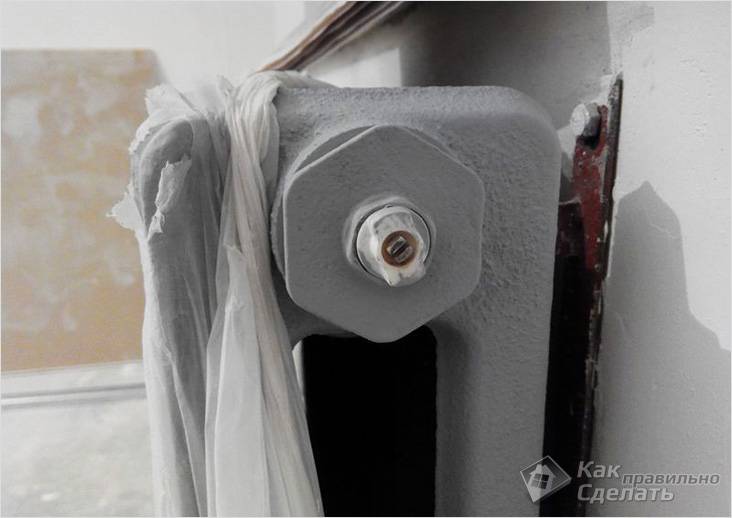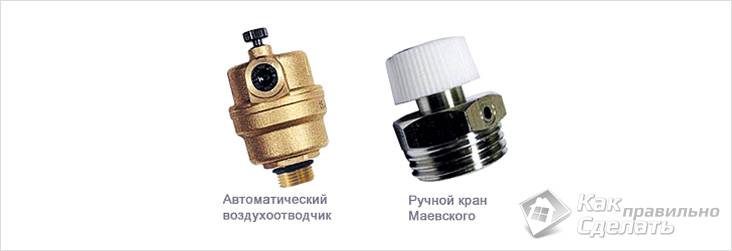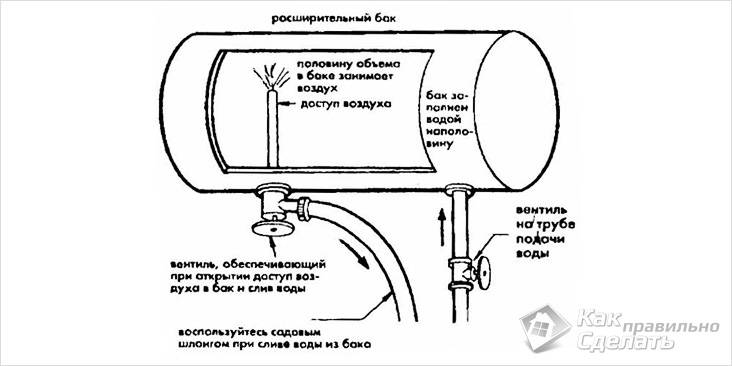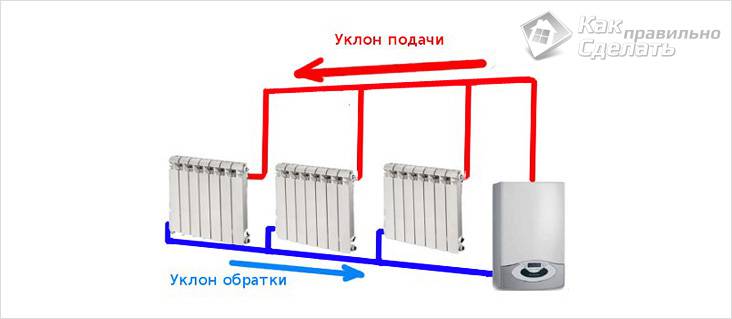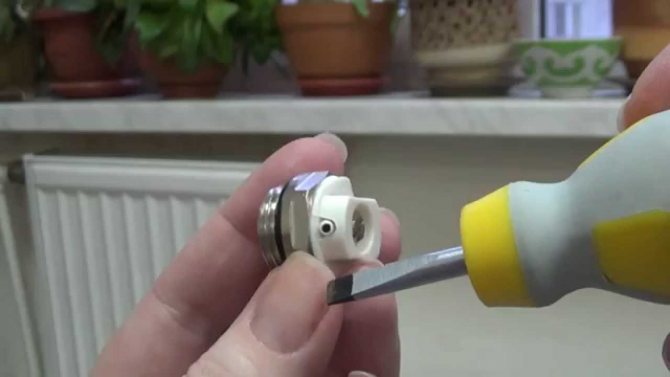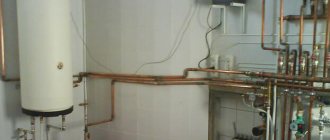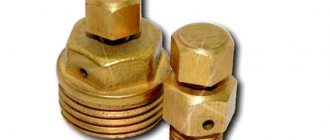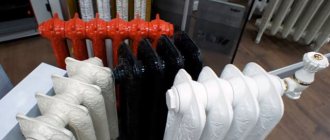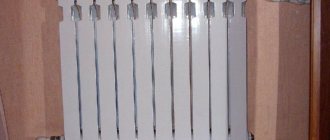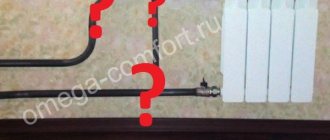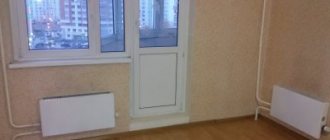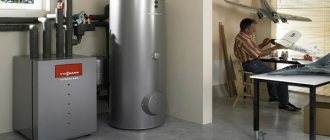How to avoid air congestion
The sequence of preventive measures depends on the type of heating system.

Open circuit
A system of this type is filled with hot water on its own. All valves on radiators must be open to allow unobstructed water access. It is necessary to monitor the force of pressure and not to allow too strong and rapid filling. Close the drain valve when filling the empty space of the batteries.
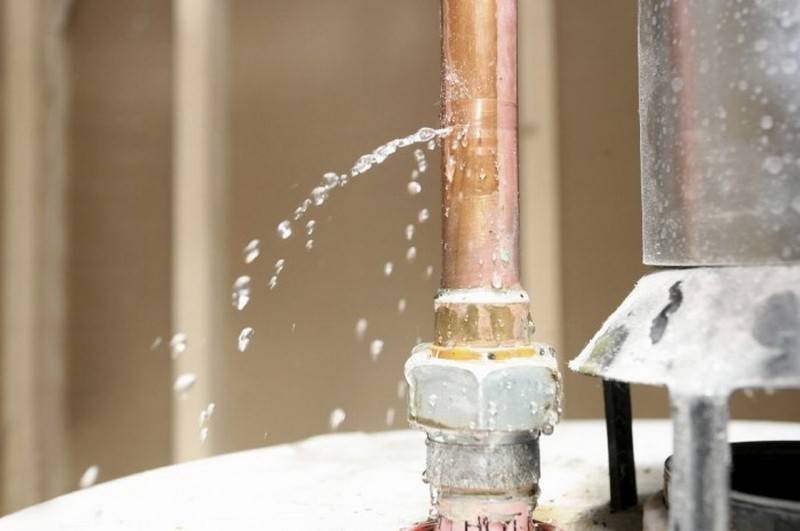

Filling closed systems
The steps to complete this type of system differ from the standards. On the contrary, the valves are primarily closed. Only the one through which water is poured into the system is left open. Then a pump is connected to ensure a stable pressure in the pipes. The air from the batteries is released using taps only after the entire system is filled with water.
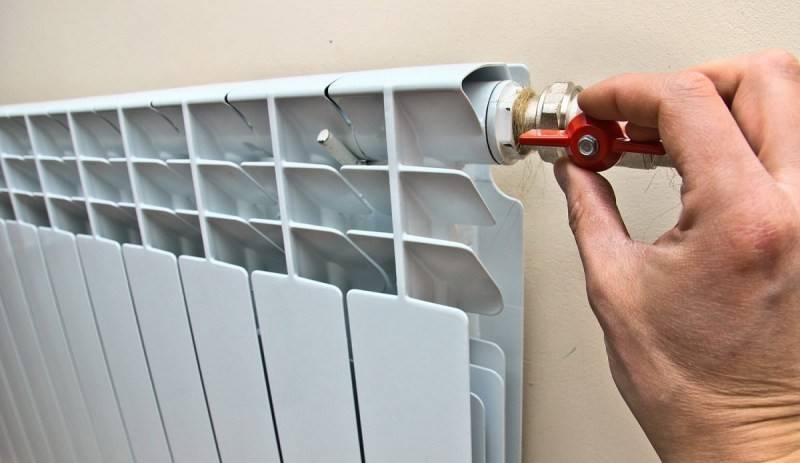

You see, if you follow the rules and carry out prevention, it is quite possible to minimize the likelihood of air jams in the heating system, which reduce the temperature regime in the apartment.
Recommendations for venting radiators
Consider three possible options for the production of work:
- in the presence of an air vent;
- if a conventional tap is installed on the radiator;
- any fittings are missing.
There is no difficulty in bleeding air from a battery equipped with a manual air vent - a Mayevsky crane. To do this, arm yourself with a crane unscrewing tool, a small container and a rag.
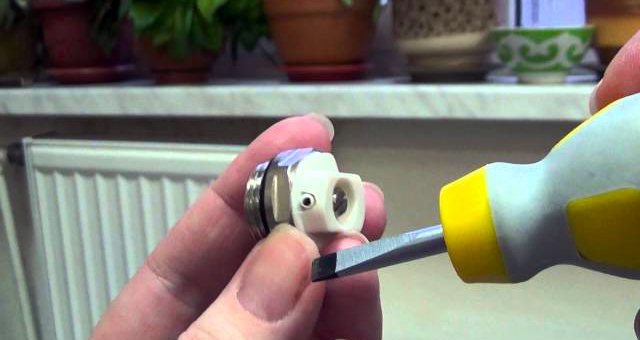

Note. Different modifications of the Mayevsky crane can be equipped with screws for different tools. Most often, they are made for an ordinary flat screwdriver, sometimes for a special key or with a plastic handle that does not require a tool.


After spreading a rag on the floor, you need to make sure that the side hole of the drain cock is not directed towards the wall. If so, then you need to cover it with something so that dirty water does not get onto the finishing material of your room. Further, a container is placed under the hole, and with a screwdriver (or other tool), carefully and slowly unscrew the screw until a characteristic hiss appears. Here you have to stop and wait until the sound disappears.
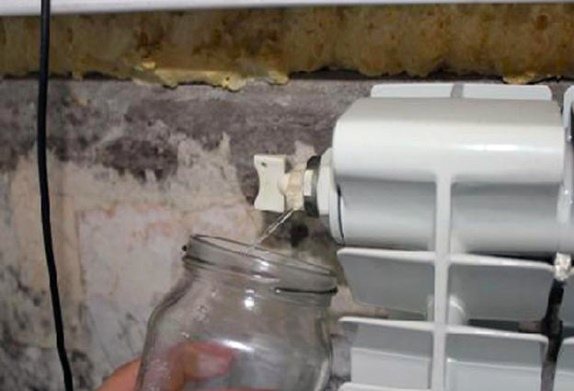

The cessation of hissing does not at all indicate that the air in the battery has already ended and all has gone out. Part of it remains mixed with the coolant, so it is necessary to unscrew the screw a little more until water comes out of the hole. Here you need to be especially careful, since in the first moments the coolant may come out unevenly and with splashes. After waiting for a small stable stream, you can turn the valve. To make sure that everything is done correctly, you need to feel the previously cold part of the battery after a few minutes, it should warm up. If this does not happen, the operation should be repeated.
Often, on various Internet resources or forums, not entirely correct advice is given on eliminating air accumulations from heating equipment. For example, that before unscrewing the needle valve of the air vent, you need to go to the basement and shut off the entire riser. Or even worse - that you have to wait until the coolant in the system has cooled down.
Remember that air will only leave the battery under the pressure of the water displacing it. Being on the top floor and turning off the riser, you reduce the pressure and success of your event to zero.On the lower floors, when disconnected, the pressure of the water column located above your apartment will remain, but its value will not be enough.
The conclusion is simple: if you do not plan to disassemble the heater, then you do not need to shut off anything to perform air bleeding, you just need to take measures so that hot splashes do not burn your hands.
Reasons for airing the system
There are several fairly common reasons that provoke the appearance of an air lock inside heating structures:
- depressurization that occurred during the implementation of scheduled preventive or repair work;
- incorrect flushing or pressure testing of the system, followed by filling the water circuit with a standard coolant;
- local violation of the integrity of pipelines and radiator batteries under negative external influences or as a result of maintenance and operation errors;
- in private households - the absence of a sufficient pipe slope and an expansion tank in the installed system;
- reduced pressure level in the water supply system, filling the formed voids with air;
- faulty condition of the air intake elements;
- connection to the heating structure of the "warm floor" system with pipes of different heights;
- air suction through leaking seam joints and joint areas;
- low quality of the coolant, its oversaturation with gases;
- replenishment of the volume of the heat carrier by adding cold tap water.
One of the most common problems is the presence of errors and inaccuracies at the stage of creating project documentation or installing piping.
Heating system without air pockets
To prevent air from accumulating in problem areas in an individual heating system, but to go outside, it is necessary:
- correctly design and install the pipeline, correctly install the radiators;
- use automatic and manual air vents.
Consider how to expel air from a heating system with natural circulation and top wiring
When arranging the pipeline, it is important to observe such an angle of inclination at which air bubbles move freely up to the highest point of the contour, without accumulating at turns and gentle sections. At the highest point of such a system, an open-type expansion tank must be installed through which air bubbles enter the atmosphere.
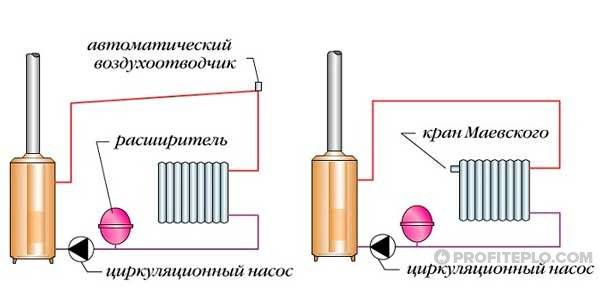

Bleeding air from the heating system using an automatic air vent
A different principle is used to bleed air from a forced movement system or a gravity system with a bottom wiring.
... Return pipelines are installed under a slope (this simplifies the drainage of fluid from the system), and automatic valves are installed at the top of all individual circuits, through which air is discharged as it accumulates.
In addition to automatic air vents, the system also uses Mayevsky's manual taps. Such air vents are mounted on heating radiators - on the upper branch pipe on the opposite side of the pipe supplying the heated coolant. In order for air to enter the valve, and not accumulate in the upper radiator manifold, it is recommended to install the heating device at a slight angle. Air venting is done manually as needed.
How to find an airlock?
Ideally, the system is able to cope with the airing on its own thanks to the automatic valves through which the air is released. Having found that a separate heating device or part of the circuit does not work properly, it is necessary to find a place where an accumulation of air has formed.
Touch the radiator - if its upper part is colder than the lower one, it means that the coolant does not enter there
... To release the air, open the Mayevsky tap mounted on a steel, aluminum or bimetallic radiator, or a valve tap mounted on cast iron batteries.
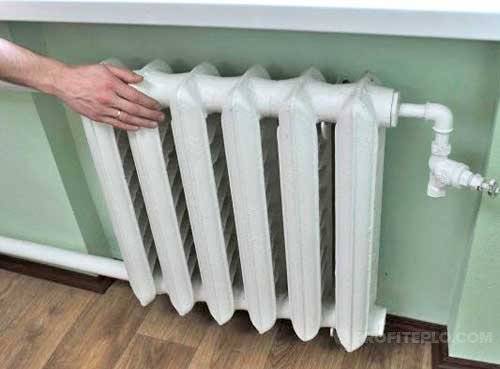

How to identify an airlock in a battery
You can also determine the place of airing by sound - under normal conditions, the coolant moves almost silently, extraneous gurgling and overflow sounds occur due to an obstacle in the flow
.
Metal pipes and heating devices are tapped with light blows - in places where air accumulates, the sound is noticeably louder.
Getting rid of the airlock
If there are manual air vents on the radiators, there are no problems with how to remove air from the batteries. Using a screwdriver or a standard key, the stem of the Mayevsky valve is slightly unscrewed, while a suitable container is placed under the drain hole (a half-liter glass jar is enough). Bleeding air from the heating system using a manual air vent is accompanied by hissing and whistling, then splashes appear, after which the coolant begins to flow in a thin stream. At this stage, the Mayevsky valve should be closed.
To remove an air lock from the heating system, if it has accumulated on the side of the air vent (manual or automatic), proceed as follows
:
- Open the air valve or valve closest to the air bubble.
- They begin to gradually feed the system with a coolant so that the liquid, by increasing the volume, displaces the air bubble towards the open air vent.
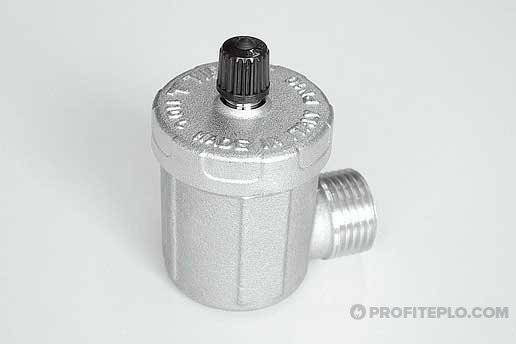

Automatic air vent valve with angle connection
What to do in difficult cases when the plug is not removed by adding the volume of the coolant? In such a situation, in addition to increasing the amount of coolant, it is required to add pressure, heating the liquid to critical temperatures. You should be extremely careful not to be scalded by splashes that accompany the air release through the automatic valve.
Reasons for the appearance of air in the heating system
The appearance of air in the heating system can occur for various reasons. If this is a one-time problem, then you can delete it and no longer search for reasons. If airing occurs repeatedly during the season, then it is worth looking for the reason.
Heating system repair
Repairing or upgrading the heating system can lead to air build-up. During repair work, air almost always enters the pipeline. You can't get away from this.
Filling the heating system with coolant
Filling the system with a coolant requires some care. If water is poured into the heating system slowly, then little air remains, since most of it is displaced. Here, too, nothing can be done.
Depressurization of the heating system
Usually, the joints and welds are depressurized, through which air begins to enter the heating system. This defect requires urgent elimination, since in this case airing will occur constantly. In heating systems of private houses, this phenomenon is accompanied by a drop in pressure.
The most likely place where you need to look for a place for depressurization is the joints of pipes and radiators. As a rule, it is very difficult to look for them, since they do not always appear outwardly. Alternatively, rust may appear in the leaky place due to the appearance of moisture. But if outwardly everything looks normal, and air enters the heating system all the time, you will have to use soap foam. It is used to coat the joints and welded joints of pipes and observe whether air bubbles appear. If leaking connections are detected, they must be tightened or even this connection must be repaired.
Valve performance
If the heating system of your house already has air relief valves, and air locks still begin to appear in it, you need to check the serviceability of these valves, as well as the tightness of their connections.
The appearance of air in the heating system can also be associated with a rupture of the expansion tank diaphragm. In this case, you will have to change the membrane. This can be determined by the expansion tank air nipple. If, when pressed, a coolant flows out of it, then the membrane is leaking.
It is worth remembering that it is necessary to check the heating system for airiness at least every year during the autumn start-up of heating.
Methods for removing air from hot water heating systems
Since heating can be both natural and forced circulation of the coolant, the air in the heating system can also be removed in different ways.
For systems with natural circulation (top piping is considered), the air lock can be removed through the expansion vessel, which should be at the highest point relative to the entire system.
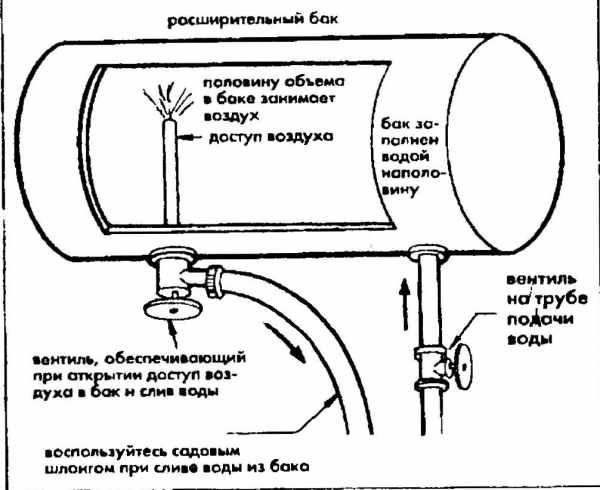

Removing air through the expansion tank. Click to enlarge.
The supply line should be laid with a rise towards the tank. If the wiring is lower, it is necessary to provide for air removal in the same way as in a heating system with a circulation pump.
For systems with forced circulation, an air collector should be provided - at the highest point, which will be responsible for air release.
In this case, the supply pipeline is laid with a rise in the direction of movement of the coolant, and air bubbles, rising along the riser, are removed from the heating system through air taps, which must be installed at the highest point.
In any case, the return pipelines should be laid with a certain slope - towards the water drain in order to speed up the emptying of the pipes during repair work.
In closed-type heating systems, automatic air vents are provided - they are installed at several points along the pipeline, the air from which is discharged separately.
If the installation of the heating system and the laying of pipes at the required slope are done correctly, then bleeding through the "air vents" will be simple and not entailing any problems.
I would like to note that the removal of air from the pipes is accompanied by an increase in the flow rate of the coolant and an increase in pressure in them. In the case of airing heating batteries, there may be poor tightness of heating pipelines or uneven temperature differences.
Very often, in residential buildings equipped with an autonomous boiler with an open heating system, water can be discharged directly through the expansion tank: after emptying, it is advisable to wait at least half an hour and only then open the "air vent" on the tank - all the air will go out on its own when the water temperature in the system rises ...
How to remove excess air from the battery?
Before you bleed the air from the heating system, you need to understand well the features of this procedure and prepare all the necessary tools and materials. Let's consider how to remove air from the heating system in more detail. For such work, you will need a special key with which you can open the air valve on the radiator.
A radiator wrench works best. It is sold in any hardware store. If a modern battery is installed, you can use a simple screwdriver. It is also necessary to prepare a container into which the coolant will be drained. And also have a couple of rags nearby in case of unforeseen situations.
The algorithm of actions on how to properly bleed air from the heating system is given below:
- Examine the battery and find a small valve (or Mayevsky's tap, as it is most often called). Install it at the top of the radiator. Sometimes there are several such devices. But they often manage with one valve.
- Unscrew the tap until you hear a hiss of air. Unscrew carefully, smoothly.
- Place a container under the valve.
- You need to wait until all the accumulated air comes out. When the water comes out in a thin stream and stops bubbling, it means that the air has left the system. Some experts advise to drain about 2-3 buckets of water after the water without gases starts to run. This is done for reinsurance so that you do not have to perform such operations again.
- Turn the tap back on.
In addition to Mayevsky's taps, automated air vents are often used for heating systems, which release excess air on their own. Such automatic units are compact and reliable. But at the same time, you have to be extremely careful. After all, the valve works unattended. And the slightest violation in the process can cause the attic or riser to be heated.
Some nuances
There are situations when the masters, when installing the heat supply system, do not install special valves to release excess air. Consider how to release air from the radiator in this case. For work, you will need an adjustable or gas wrench. With its help, you need to unscrew the plug. This should be done very slowly. Sometimes the plug won't unscrew. This most often happens if the battery is cast iron. In this case, it is necessary to apply a special lubricant to the thread and after a while try again.
When the plug is unscrewed, the same sequence of actions is performed as with a conventional tap. When the plug is screwed into place, remember to wind either FUM tape or flax onto the threads. This will avoid leaks and will seal the connection.
If air has accumulated in the heating system of a private house, the water will have to be drained using an expansion tank.
This tank is always located at the highest point of the heating system. When the water is drained, you need to wait a little, and then unscrew the tap on the expansion tank. Usually, when the temperature of the battery rises, the plug comes out on its own. If such actions turned out to be ineffective, then you should bring the water in the circuit to a boil. In this case, the cork will definitely come out.
How often should the air be deflated?
Knowing how to bleed air from the heating system can prevent and solve many problems. But how often should such a procedure be carried out in order to prevent it? As a rule, this should be done at the beginning of the heating season. Two times is quite enough (the first time for checking, the second for checking). Of course, if the system has defects or it is faulty, then the number of descents can be large.
If the apartment has aluminum radiators, then before starting the system it is necessary to drain the water. This will help increase battery life dramatically.
Reasons for the formation of air congestion
For efficient heating of your home, it is necessary to remove air "plugs" in a timely manner.
"Blockage" or an air lock can form in pipelines if:
- The heating system was being repaired - during the repair work, the appearance of air is inevitable.
- When laying and installing pipes, the required slope and its direction were not observed.
- Pressure drops - since the water level in the pipes drops over time, the pipelines are emptied, filling with air.
- A heating system with natural circulation of the coolant has been installed (in private houses of small areas, heating is arranged without forced circulation, i.e., a circulation pump is not installed). In this case, airing of the heating system occurs due to a possible pressure drop in the pipes.
- The coolant leaks through poorly sealed pipe joints. It is rather difficult to notice a leak if the flaw is small (for example, the connection is not very tight), and hot water can flow and evaporate immediately.
- The heating system does not fill up correctly after a long period of inactivity (in autumn). Some homeowners strive to fill the pipes with water quickly and "to capacity", but this is wrong. Filling should be done slowly while removing air from the heaters and distribution pipes.
Air can also enter the pipes directly with the coolant - as you know, there is some content of air bubbles in the water, which rise up when the temperature of the water rises.
In houses where water "warm floors" are also connected to the common distribution manifold, it is also possible to observe the formation of an air lock in the heating system.
The reasons are almost the same, but the elimination of this problem is quite problematic, since the pipes are unevenly located in their height. Hence the conclusion: it is necessary to constantly monitor the pressure and flow rate of the coolant in the pipes or install air collectors (they are also called "air vents").
Signs and causes of air in the radiator
It is necessary to bleed air from the radiator in the event of the following problems:
- heat exchangers do not warm up;
- pipes make noise, gurgle, etc .;
- the pressure in the heating system decreased with increased fuel consumption (if the heating is not central);
- there is a water leak;
- water does not move (with natural circulation).
It is certainly necessary to release air from the radiator, otherwise the house will not warm up, but this is only the tip of the iceberg. The worst thing that can happen is oxidation and further deterioration of the steel elements. The pipes will need to be cleaned or new ones installed.
It is extremely important to bleed air from the radiator, otherwise the circulation pump may break. This is explained as follows: bearings, operating without water lubrication, will begin to generate heat, which ultimately destroys the sliding rings and the shaft.
Of course, it is simply necessary to release air from the radiator. But first let's talk about the reasons for its accumulation:
- recently carried out installation / renovation work;
- ill-conceived heating system;
- insufficient pressure;
- excessive heating of water;
- non-observance of the rules for filling the system when starting it;
- violation of the tightness of the joints;
- installation of a "warm floor" located below the level of the radiators;
- rusty pipes (from the inside);
- too high speed of the coolant;
- defective air intake devices.
Note! How to vent air from a radiator made of aluminum? Unfortunately, this issue is of concern to apartment owners in multi-storey buildings. Excessive gassing is due to the fact that metal and water interact with each other.
To minimize the likelihood of this problem, it is better to install bimetallic, steel or cast iron radiators. It is good if automatic air vents are installed to allow air to be released from the heat exchanger (before the next scheduled repair).
Read the material on the topic: Types of heating radiators
How to get rid of an airlock
Unfortunately, the airlock is not always in an easily accessible place. In the event of design or installation errors, air can accumulate in the pipes. Bleeding him out of there is very difficult. First, we determine the location of the plug. In the place of the plug, the pipes are cold and a murmur is heard. If there are no obvious signs, they check the pipes by sound - they tap on the pipes. In a place where air is accumulated, the sound will be louder and louder.
The found airlock must be expelled.If we are talking about the heating system of a private house, for this, the temperature and / or pressure is raised. Let's start with the pressure. The nearest drain valve (in the direction of movement of the coolant) and the make-up valve are opened. Water begins to flow into the system, raising the pressure. It forces the plug to move forward. When air enters the vent, it comes out. Stop making up after all the air is gone - the drain valve will stop hissing.
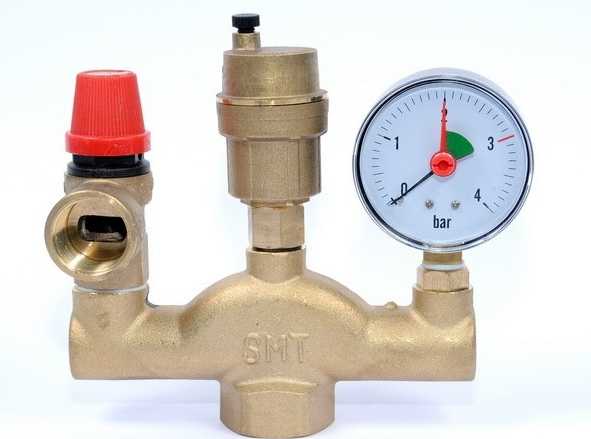

This is a security group. An automatic air vent is installed at the middle outlet
Not all air locks give up so easily. For extra stubborn, it is necessary to simultaneously raise the temperature and pressure. These parameters are brought to values close to the maximum. You cannot exceed them - it is too dangerous. If after that the plug has not gone away, you can try to open simultaneously the drain valve (to drain the system) and the make-up valve. Maybe this way it will be possible to move the airlock or get rid of it altogether.
If a similar problem occurs constantly in one place - there is an error in the design or wiring. In order not to suffer every heating season, a valve for air exhaust is installed in the problem area. A tee can be cut into the line and an air vent can be installed on the free inlet. In this case, the problem will be solved simply.
Reasons for the formation of air congestion
Getting rid of air in the system
Why does air appear inside a sealed heating system? This can happen due to:
- Failure to comply with the standard for the direction of the slope and the places of bends of the main pipelines during installation work.
- Incorrect filling of the entire system with water.
- Loose connections of various components and elements that contribute to the suction of air from the external environment.
- Incorrect operation of the air vents or their absence.
- Carrying out repair work to replace risers, locking mechanisms, heating devices, as a result of which air enters the heating system
- Using fresh water to refill the system. Cold water contains a fairly large amount of dissolved oxygen. As the temperature rises, its concentration in water decreases significantly. The air from the coolant is released by small bubbles, which rise and are collected by an air lock at the extreme upper points of the heating system and radiators.
Installation of air vents
At all upper points of the system, be it pipe bends or radiators, air vents need to be installed - the main tool in the fight against congestion. The air vent can be automatic (valve) or manual (Mayevsky valve). The automatic valve will do everything by itself, unnoticed by the owner.
In order for the automatic air release valve to work properly, you need to make sure that the coolant is clean all the time.
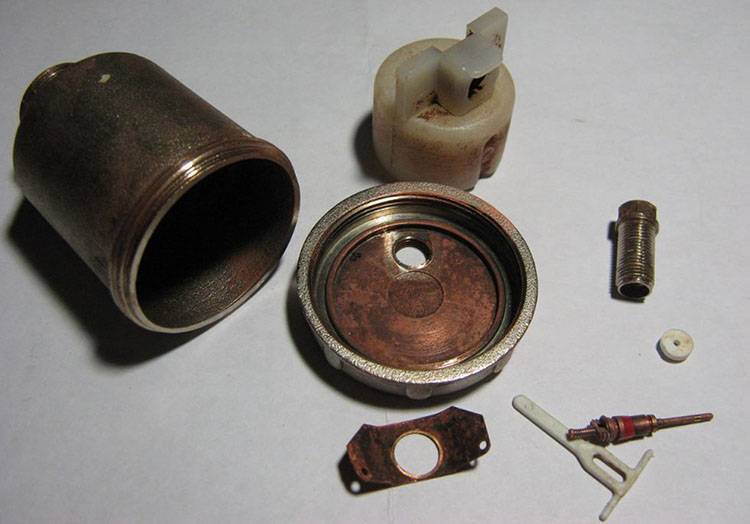

Internal structure of the automatic air vent
In manual mode, if signs of airiness appear (decrease in temperature in the area, gurgling, drop in pressure), you need to immediately take care of the release of air.
When replacing a radiator, they buy a mounting kit, which has everything you need for installation, including the Mayevsky crane. But air vents are sold separately. They are placed in the upper radiator nozzle, on the opposite side from the supply inlet.
Installing air relief valves
To remove air from the heating, air vents are installed on the radiators - manual and automatic air valves. They are called differently: a vent, an air vent, a bleed or air valve, an air vent, etc. The essence does not change from this.
Mayevsky air valve
This is a small device for manually bleeding air from heating radiators. It is installed in the upper free radiator manifold. There are different diameters for different sections of the collector.
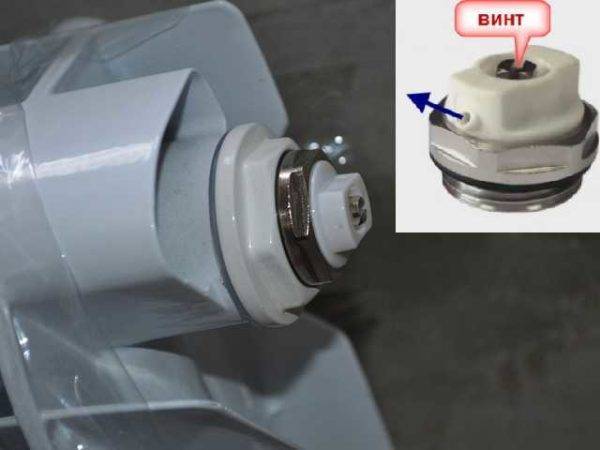

Manual air vent - Mayevsky crane
It is a metal disc with a conical through hole. This hole is closed with a tapered screw. By unscrewing the screw a few turns, we provide an opportunity for air to escape from the radiator.
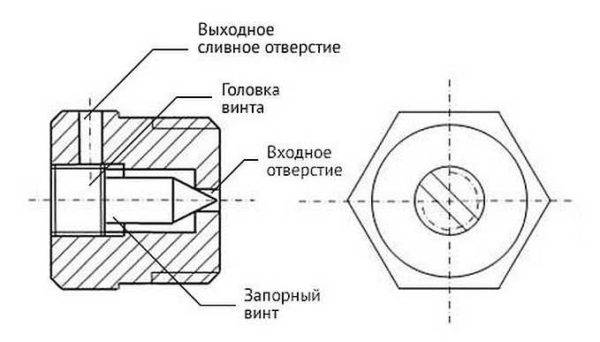

Device for venting air from radiators
To facilitate the air outlet, an additional hole is made perpendicular to the main channel. Through it, in fact, the air comes out. While airing with a Mayevsky crane, direct this hole up. After that, you can unscrew the screw. Unscrew a few turns, do not twist too much. After the hissing stops, return the screw to its original position, go to the next radiator.
When starting up the system, it may be necessary to bypass all air collectors several times - until the air stops coming out altogether. After that, the radiators should warm up evenly.
Automatic air relief valve
These small devices are installed both on radiators and elsewhere in the system. They differ in that they allow you to bleed air in the heating system in automatic mode. To understand the principle of operation, consider the structure of one of the automatic air valves.
The principle of the automatic escapement is as follows:
- In the normal state, the coolant fills the chamber by 70 percent. The float is at the top, presses the stem.
- When air enters the chamber, the coolant is displaced from the body, the float is lowered.
- He presses a ledge-flag on the jet, squeezing it out.
- The wrung out orifice opens a small gap, which is enough for the air that has accumulated in the upper part of the chamber to escape.
- As the water escapes, the air vent body fills with water.
- The float rises, freeing the stem. It is returned to its place by means of a spring.
Different designs of automatic air valves work according to this principle. They can be straight, angular. They are placed at the highest points of the system and are present in the security group. They can be installed in identified problem areas - where the pipeline has an incorrect slope, due to which air accumulates there.
Instead of Mayevsky's manual taps, you can put an automatic drain for radiators. It is only slightly larger in size, but it works in automatic mode.
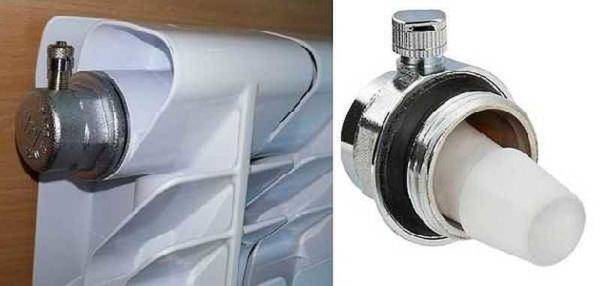

Automatic air vent for venting
Salt cleaning
The main trouble with automatic valves for venting air from the heating system is that the air outlet is often overgrown with salt crystals. In this case, either the air does not come out or the valve starts to "cry". In any case, you need to remove and clean it.
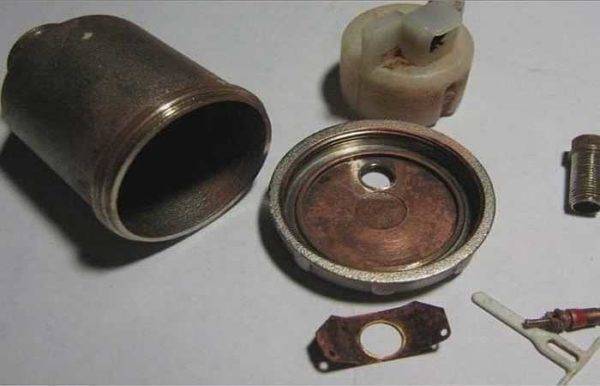

Disassembled automatic air vent
So that this can be done without stopping the heating, automatic air valves are paired with non-return ones. A check valve is installed first, an air valve is installed on it. If necessary, the automatic air collector for the heating system is simply unscrewed, disassembled (unscrewed the lid), cleaned and reassembled. The device is then ready to bleed air from the heating system again.
How to bleed air from a radiator if there is no tap
You can release air from old cast-iron radiators with the help of plumbers from the housing office (see the decree of the Ministry of State Construction dated 09/27/03). However, in reality, plumbers rarely help to release air.
In their homes, the owners themselves release the air from the radiators. There are craftsmen who independently install taps on them in order to make it easier to release the air. You can release air from a cast-iron radiator in the following way.
When heating the house individually, you must first turn off the boiler.If it is necessary to release air from the radiator in the apartment, then tighten the distribution valve on the riser. Now a long hose is inserted into the hole of the radiator, stretched to the sewer.
Advice. We recommend that you prepare a basin (for a battery) and dry rags in advance, since there will be a lot of water.
After that, you need to remove the plug, which can be difficult due to the dried oil paint around it and the applied tow. To simplify this process, a special lubricant can be used. An adjustable wrench is required at this stage.
Advice. If, even with lubrication, the plug cannot be unscrewed, then the paint should be dissolved with kerosene (this will take about 20 minutes).
In conclusion, you need to wrap the plug with FUM tape, attach it.
Whether or not it is necessary to release air from the radiator is up to the owners. However, we recommend that you still learn this in order to control the operation of the heating system. It is actually quite easy to release air from the radiator, it is important to follow the technology of this process.
Read the material on the topic: Heating radiators wholesale with delivery and quality assurance
Filling the system with water
- To begin with, we open all the taps (on both sides of the pump, on all radiators, on the collectors of the water floor, on the expander), and Mayevsky's taps are closed.
- The system must be filled from the bottom up. The inlet is made at the lowest part (through it, the coolant is drained and poured).
- From above, the main valve (at the highest point of the system) opens to release air and slowly fills. There is no need to rush, just so that the air can escape. The fluid supply remains open until water comes out of the valve.
- The system builds up the pressure recommended for it as a working one. Then, one by one, the air is vented from each radiator in the house (it's time to turn off the tap when the water runs in a trickle).
- There is a screw in the central part of the circulation pump, which is slightly unscrewed with a screwdriver. Air is vented from the pump, then twisted.
- After the air is vented, the pressure in the system will drop and it will be necessary to turn on the water supply again to make up for the losses.
- After that, a test run of the boiler is done at a low temperature (about 40 ° C), with the pump turned on. During this start-up, it is advised to bypass and look through all the elements of the system - if there is a leak, if air is coming out somewhere, if all radiators are warming up evenly. Then, you may need to add water again and then start the boiler into operating mode.
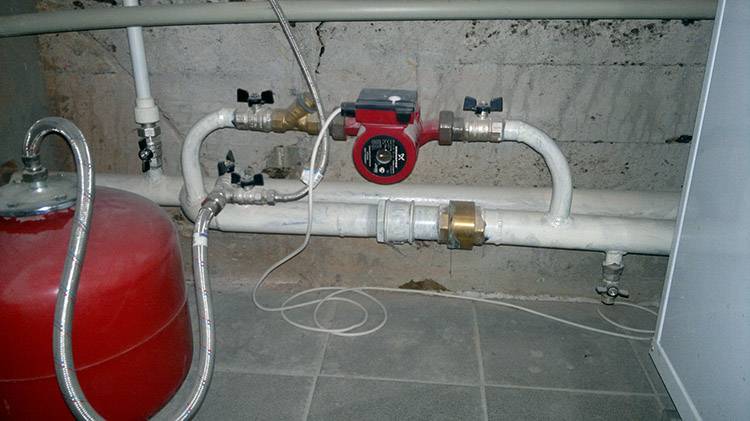

Filling the system with water
If suddenly one of the valves remains closed, and the system is already full and the pressure is high, you need to open the valve very slowly and carefully. Otherwise, you will get a decent water hammer.
Bleeding without a tap
It is most difficult to bleed air if there is no Mayevsky crane and other fittings. Good news for those who have modern sectional radiators: you can gently unscrew the top cap in them. True, you will have to cover everything with rags and perform the operation very slowly and carefully. It is not required to completely unscrew the plug, it is necessary to make 1-2 turns so that the air can pass along the thread.
Advice. Often the batteries are equipped with ball valves and thermostats. It makes sense to try to release air through them.


Owners of cast-iron Soviet "accordions" of the MS-140 type are much more risky to perform the operation. Not only is it not easy to move a large old nut from its place, but there is also a danger that after tightening the gasket will cease to hold and a leak will appear. Then the exhausting work of emptying the riser and installing the same Mayevsky valve in the plug is waiting for you. Although for such events it is supposed to involve a team from the local utilities.
Methods for removing an airlock from the cooling system
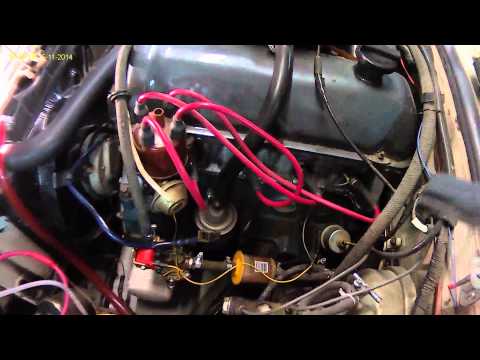

How to expel an airlock from the cooling system of a VAZ classic
There are three main methods by which an airlock can be removed. Let's list them in order. The first method is great for VAZ vehicles. Its algorithm will be as follows:
Remove any guards or other items from the engine that might prevent you from reaching the coolant expansion tank. Disconnect one of the nozzles that are responsible for heating the throttle assembly (it does not matter, direct or reverse). Remove the expansion tank cap and cover the neck with a loose cloth. Blow inside the tank. In this way, you will create a slight excess pressure, which will be enough for the excess air to escape through the nozzle. As soon as antifreeze comes out of the hole for the branch pipe, immediately put the branch pipe on it and, preferably, fix it with a clamp
Otherwise, air will get into it again. Close the expansion tank cap and reassemble all previously removed engine protectors.
The second method is carried out in accordance with the following algorithm:
- Start the engine and let it run for 10 ... 15 minutes, then turn it off.
- Remove the necessary elements in order to get to the coolant expansion tank.
- Without removing the lid from it, disconnect one of the nozzles on the tank. If the system has been airy, then air will begin to come out of it.
- As soon as the antifreeze pours out, immediately reinstall the pipe and fix it.
When doing this, be careful, since the temperature of the antifreeze can be high and reach a value of + 80 ... 90 ° C.
The third method of how to remove an air lock from the system must be done as follows:
Place the machine on a hill so that its front is higher
It is important that the radiator cap is higher than the rest of the cooling system. At the same time, put the car on the handbrake, or better place stops under the wheels. Let the engine run for 10 ... 15 minutes. Unscrew the caps from the expansion tank and radiator. Periodically press the accelerator pedal and add coolant to the radiator
In this case, air will escape from the system. You will notice it by the bubbles. Continue the procedure until all the air is gone. In this case, you can turn on the stove to the maximum mode. As soon as the thermostat opens the valve completely and very hot air enters the passenger compartment, it means that the air has been removed from the system. At the same time, it is necessary to check for bubbles escaping from the coolant.
As for the latter method, on machines with an automatically switched on cooling system fan, you can not even over-gas, but calmly let the engine heat up and wait for the fan to turn on. At the same time, the movement of the coolant will increase, and the circulation will cause air to escape from the system.
In this case, it is important to add coolant to the system in order to prevent air bubbles again.
As you can see, the methods of how to get rid of an airlock in the engine cooling system are quite simple. They are all based on the fact that air is lighter than liquid. Therefore, it is necessary to create conditions under which the air lock will be forced out of the system under pressure. However, it is best not to bring the system to that state and take preventive measures in time. We will talk about them further.
Why batteries do not heat well
Cold batteries
During the heating season, many radiators do not heat very much, so the room is cold and uncomfortable. There may be several reasons for this.
The first is that air has accumulated in the battery. This is indicated by a characteristic gurgling sound. The radiator becomes partly cold due to insufficient circulation of the coolant. In such a situation, it is very easy to purge the battery.If an aluminum radiator is installed with a thermostat, it is enough to open it completely and bleed the air. If there is no thermostat, open the Mayevsky tap or plug.
When opened through the hole, air will be blown out with a strong hiss. It must be vented until it all comes out and water flows. Its uniform jet will indicate that the airlock has been eliminated and the radiator can be operated normally. On cast iron radiators, special valves are used to bleed air.
The second reason for poor circulation of the coolant is not air, but a dense plug of scale and large particles that run through the heating system along with hot water
Experts pay attention to the fact that even a millimeter thickness of scale deposits reduces the heat transfer of the battery by 15%. Therefore, it is advisable to purge the system before the start of each season and do it correctly.
How to understand that accumulated scale is the reason for the ineffective operation of heating devices in the apartment? You need to pay attention to the following signs:
- The walls are covered with limescale if the riser is hotter than the radiator.
- Feel the radiators in all rooms in the apartment. Their different intensity of heating is a reason for "treatment".
- Uneven heating of sections of one battery.
What methods are there to fix these problems?

